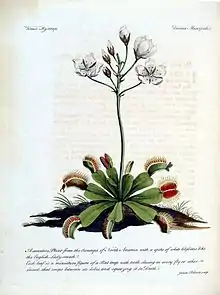John Ellis | |
|---|---|
| Born | c. 1710 |
| Died | 15 October 1776 (aged 65–66) |
| Occupation(s) | Naturalist, linen merchant |
| Awards | Copley Medal 1767 |
00.jpg.webp)

John Ellis FRS (c. 1710 – 15 October 1776) aka Jean Ellis was a British linen merchant and naturalist. Ellis was the first to have a published written description of the Venus flytrap and its botanical name. The standard author abbreviation J.Ellis is used to indicate this person as the author when citing a botanical name.[1]
Ellis specialised in the study of corals. He was elected a member of the Royal Society in 1754 and in the following year published An essay towards the Natural History of the Corallines. He was awarded the Copley Medal in 1767. He was elected to the American Philosophical Society in 1774.[2] His A Natural History of Many Uncommon and Curious Zoophytes, written with Daniel Solander, was published posthumously in 1776.
Ellis was appointed Royal Agent for British West Florida in 1764, and for British Dominica in 1770.
He exported many seeds and native plants from North America to England. He corresponded with many botanists, including Carl Linnaeus.
Taxonomist
Venus's Fly-trap
A royal botanist, William Young imported living plants of the Venus flytrap to England. They were then shown to Ellis. In 1769, he wrote a description of the plant discovery from North Carolina to send to the 'Father of Taxonomy', Carl Linnaeus. Ellis also gave it the scientific name of Dionaea muscipula. Later, his essay Directions for bringing over seeds and plants, from the East Indies (1770) included the first illustration of a Venus Flytrap plant.[3]
Honours
He was honoured by having 2 plant genera named after him, Ellisia (in 1763[4] ) and Ellisiophyllum (in 1871[5]).[6]
See also
References
- ↑ International Plant Names Index. J.Ellis.
- ↑ "APS Member History". search.amphilsoc.org. Retrieved 30 March 2021.
- ↑ Directions for Bringing over Seeds and Plants, from the East Indies and Other Distant Countries, in a State of Vegetation: - Together with a Catalogue of Such Foreign Plants as Are Worthy of Being Encouraged in Our American Colonies, for the Purposes of Medicine, Agriculture, and Commerce. To Which is Added, the Figure and Botanical Description of a New Sensitive Plant, Called Dionaea muscipula: or, Venus's Fly-trap (London, printed and sold by L. Davis, 1770).
- ↑ "Ellisia L. | Plants of the World Online | Kew Science". Plants of the World Online. Retrieved 6 September 2021.
- ↑ "Ellisiophyllum Maxim. | Plants of the World Online | Kew Science". Plants of the World Online. Retrieved 15 May 2021.
- ↑ Quattrocchi, Umberto (2000). CRC World Dictionary of Plant Names, Volume II, D–L. Boca Raton, Florida: CRC Press. ISBN 978-0-8493-2676-9.
External links
 Media related to John Ellis (naturalist) at Wikimedia Commons
Media related to John Ellis (naturalist) at Wikimedia Commons- Ellis, John (1773) Directions for bringing over seeds and plants, from the East-Indies and other distant countries - digital facsimile from Linda Hall Library
- "An essay towards a natural history of the corallines, and other marine productions of the like kind, commonly found on the coasts of Great Britain and Ireland. To which is added the description of a large marine polype taken near the North Pole, by the whale-fishers, in the summer 1753 ." Ellis, John, 1710?-1776 : Free Download, Borrow, and Streaming : Internet Archive. 10 June 2020. Retrieved 31 March 2021.